Research on Low-Profile Directional Flexible Antenna with 3D Coplanar Waveguide for Partial Discharge Detection
Abstract
1. Introduction
2. Flexible Antenna Design
2.1. Design Principle of CPW-Fed Monopole Antenna
2.2. Flexible Antenna Design Concept and Structure
2.3. Low-Profile Directional Flexible Ultra-Wideband Antenna Optimization and Simulation
3. Low-Profile 3D Flexible Antenna Performance Testing
3.1. Flexible Antenna VSWR Testing
3.2. Flexible Antenna Effective Height Testing
4. Flexible Antenna PD Detection Experiment
4.1. PD Experiment Platform
4.2. Impact of Antenna Bending on PD Detection Results
4.3. Influence of PD Source Position on Detection Results
4.4. Influence of Metal Obstruction on PD Detection Results
5. Conclusions
- (1)
- The designed antenna has a measured VSWR ≤ 2 in the 0.541–3 GHz frequency range. Both the measurements and experiments show that bending has a minimal effect on antenna performance, and the antenna maintains stable PD detection capabilities under different bending conditions. With a profile of 2 cm, the antenna can be flexibly installed in confined spaces like a GIS cable terminal. The antenna’s radiation pattern indicates directional signal reception, with some suppression of interference from the back;
- (2)
- The flexible antenna still exhibits good detection capability for PD signals when the height difference between the PD source and the antenna is 75 cm. It can clearly distinguish between background noise and PD signals, indicating that the flexible antenna can effectively detect PD phenomena occurring within the overall structure of the GIS cable terminal;
- (3)
- The metal obstruction in the cable terminal weakens the amplitude of the PD signal detected by the antenna by more than 20%. Furthermore, as the PD source moves deeper, the impact of metal obstruction becomes more pronounced. By comparing the flexible antenna designed in this study with existing commercial antennas, the advantages of avoiding metal obstruction for PD detection are verified.
Author Contributions
Funding
Data Availability Statement
Acknowledgments
Conflicts of Interest
References
- Xu, J.H. Gas Insulated Metal Enclosed Switchgear, 1st ed.; China Electric Power Press: Beijing, China, 2014; p. 1. [Google Scholar]
- Xu, Y.; Liu, W.; Chen, W.; Li, X.; Yang, Y.; Bi, J.G. High-sensitivity Measurement Method and Application of GIS Spacer Partial Discharge. Proc. CSEE 2020, 40, 1703–1712. [Google Scholar]
- Rodrigo-Mor, A.; Muñoz, F.A.; Castro-Heredia, L.C. A Novel Antenna for Partial Discharge Measurements in GIS Based on Magnetic Field Detection. Sensors 2019, 19, 858. [Google Scholar] [CrossRef] [PubMed]
- Gao, Y.; Shen, Y.; Xia, F.; Jiang, H.S.; Zhou, Y.; Liu, D.D. GIS Partial Discharge Signal Monitoring Device and Localization Method Based on UHF Sensor. J. Electr. Eng. 2022, 17, 244–250. [Google Scholar]
- Lemke, E.; Strehl, T.; Markalous, S.; Weissenberg, W. Ultra-wide-band PD diagnostics of power cable terminations in service. IEEE Trans. Dielectr. Electr. Insul. 2008, 15, 1570–1575. [Google Scholar] [CrossRef]
- Wang, X.H.; Li, X.; Rong, M.Z.; Xie, D.L.; Ding, D.; Wang, Z.X. UHF Signal Processing and Pattern Recognition of Partial Discharge in Gas-Insulated Switchgear Using Chromatic Methodology. Sensors 2017, 17, 177. [Google Scholar] [CrossRef] [PubMed]
- Liu, Y.S.; Zhou, W.J.; Li, P.F.; Wang, Y.; Tian, Y. Partial Discharge Ultrahigh Frequency Signal Denoising Method Based on Generalized S-Transform Modular Time-Frequency Matrix. Trans. China Electrotech. Soc. 2017, 32, 211–220. [Google Scholar]
- Li, X.D.; Li, J.; Du, L.; Qian, G.C.; Wang, P.; Zhang, J. Development of Smart Sensor for Ultra-high-frequency Partial Discharge Detection. High Volt. Eng. 2015, 41, 3944–3951. [Google Scholar]
- Mor, A.R.; Heredia, L.C.C.; Muñoz, F.A. A magnetic loop antenna for partial discharge measurements on GIS. Int. J. Electr. Power Energy Syst. 2020, 115, 105514. [Google Scholar]
- Chakravarthi, M.K.; Giridhar, A.V.; Kumar, G.A.; Sarma, D.V.S.S.S. A Compact Log Periodic Planar Dipole UHF Array Sensor for Partial Discharge Measurements. IEEE Sens. J. 2021, 21, 27748–27756. [Google Scholar] [CrossRef]
- Sun, Y.X.; Li, C.H.; Long, Y.F.; Huang, Z.Y.; Li, J. Research on flexible antenna and distributed deep learning pattern recognition for partial discharge monitoring of transformer. J. Phys. D Appl. Phys. 2024, 57, 485108. [Google Scholar] [CrossRef]
- Rui, Y.F.; Wang, Y.L.; Zhou, M.Y.; Luo, Y.; Wang, H.T.; Yin, Y. Design and Application of High-gain Steric Helical Antenna With Flexible Feeding Network for Partial Discharge Detection. High Volt. Eng. 2022, 48, 1865–1874. [Google Scholar]
- Tian, J.W.; Zhang, G.Z.; Ming, C.; He, L.Y.; Liu, Y.; Liu, J.B.; Zhang, X.X. Design of a Flexible UHF Hilbert Antenna for Partial Discharge Detection in Gas-Insulated Switchgear. IEEE Antennas Wirel. Propag. Lett. 2022, 22, 794–798. [Google Scholar] [CrossRef]
- Ma, S.J.; Wang, P.; Zhu, Y.W.; Cheng, C.Z.; Zhao, W.H. Design of Flexible Sensor for PD Detection of Inverter-fed Motors Insulation System. High Volt. Eng. 2023, 49, 4798–4807. [Google Scholar]
- Zhang, S.; Zhang, G.Z.; Lu, C.Y.; Tian, H.L.; Liu, J.B.; Zhang, X.X. Flexible Planar Monopole Built-in GIS PD Sensor Based on Meandering Technology. Sensors 2022, 22, 4134. [Google Scholar] [CrossRef] [PubMed]
- Zhang, G.Z.; Tian, J.W.; Zhang, X.X.; Liu, J.B.; Lu, C.Y. A Flexible Planarized Biconical Antenna for Partial Discharge Detection in Gas-Insulated Switchgear. IEEE Antennas Wirel. Propag. Lett. 2022, 21, 2432–2436. [Google Scholar] [CrossRef]
- Wen, C.P. Coplanar Waveguide: A Surface Strip Transmission Line Suitable for Nonreciprocal Gyromagnetic Device Applications. IEEE Trans. Microw. Theory Tech. 1969, 17, 1087–1090. [Google Scholar] [CrossRef]
- Xiao, J.K.; Wu, R.T.; Li, X.F. Self-Packaged Wideband Filtering Baluns Based on Suspended Coplanar Waveguide-Microstrip Hybrid. IEEE Trans. Compon. Packag. Manuf. Technol. 2024, 14, 489–500. [Google Scholar] [CrossRef]
- Mungaru, N.K.; Yogaprasad, K.; Anitha, V.R. A quad-band Sierpenski based fractal antenna fed by co-planar waveguide. Microw. Opt. Technol. Lett. 2020, 62, 893–898. [Google Scholar] [CrossRef]
- Mezzanotte, P.; Roselli, L.; Sorrentino, R. A Simple Way to Model Curved Metal Boundaries in FDTD Algorithm Avoiding Staircase Approximation. IEEE Microw. Guid. Wave Lett. 1995, 5, 267–269. [Google Scholar] [CrossRef]
- Li, S.Y.; Song, P.X.; Wei, Z.P.; Li, X.; Tang, Q.H.; Meng, Z.Z.; Li, J.; Liu, S.T.; Wang, Y.H.; Li, J. Partial Discharge Detection and Defect Location Method in GIS Cable Terminal. Energies 2022, 16, 413. [Google Scholar] [CrossRef]
- Affendi, N.A.M.; Amirruddin, M.; Ahmad, S. Analysis of flexible antenna performance on partial discharges detection. J. Phys. Conf. Ser. 2020, 1432, 012066. [Google Scholar] [CrossRef]
- Taher, M.A.; Othman, M.; Illias, H.A.; Latef, T.A.; Izam, T.F.T.M.N.; Azam, S.M.K.; Ullah, M.U.; Alkhatib, M.; Hussein, M.I. Conformal and Flexible Antennas in Ultra-High Frequencies: Prospects and Challenges for Partial Discharge Diagnostics. IEEE Access 2025, 13, 10139–10159. [Google Scholar] [CrossRef]
- Belov, D.A.; Stefanovich, S.Y.; Yablokova, M.Y. Dielectric Relaxation in a Thermosetting Polyimide Modified with a Thermoplastic Polyimide. Polym. Sci. Ser. A 2011, 53, 963. [Google Scholar] [CrossRef]
- Q/GDW 11304.8-2015; Testing Specification for Energized Test Device of Electrical Equipment-Part 8: Technical Specification for High-Frequency Partial Discharge Detector. State Grid Corporation of China: Beijing, China, 2015.


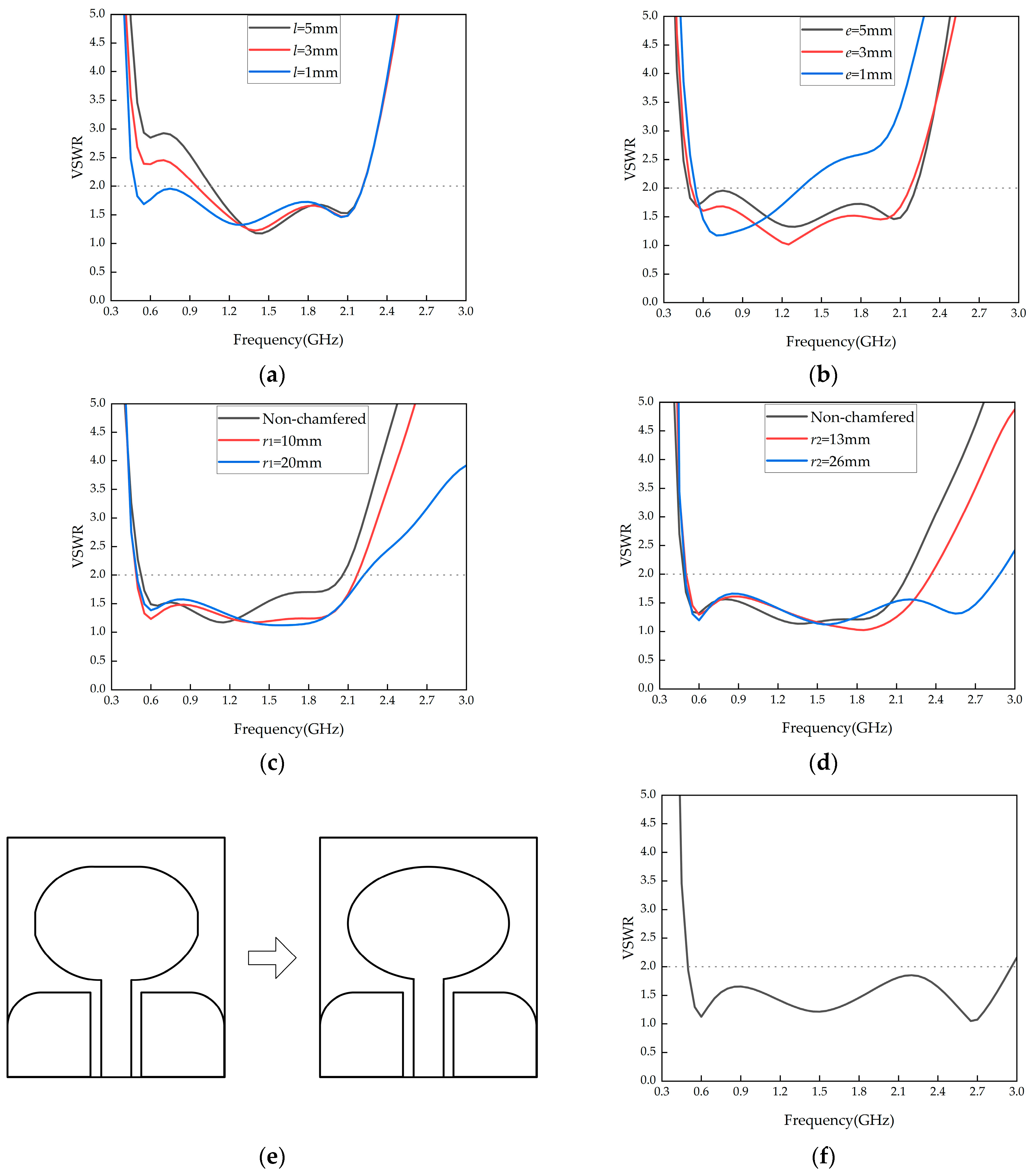


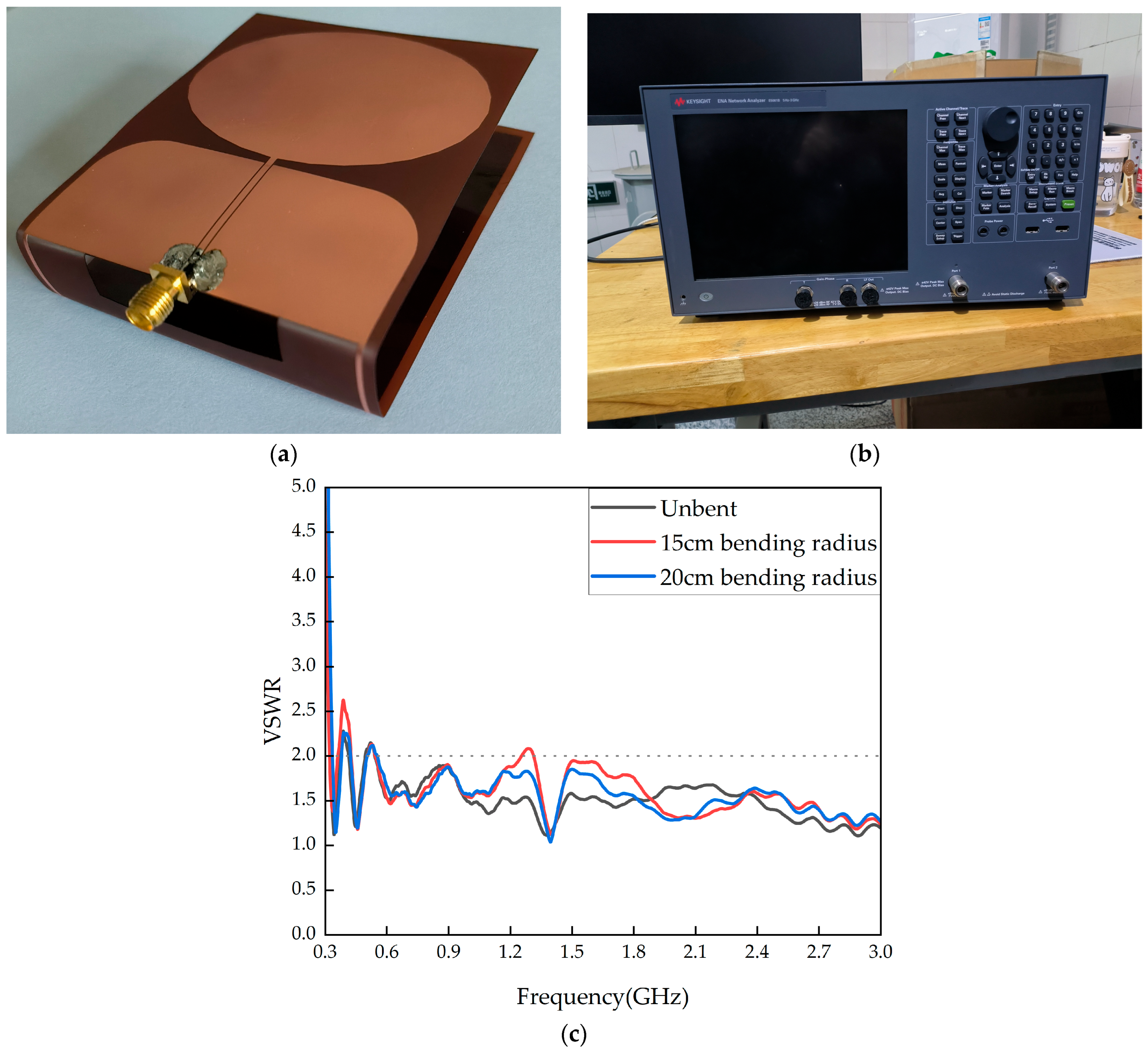
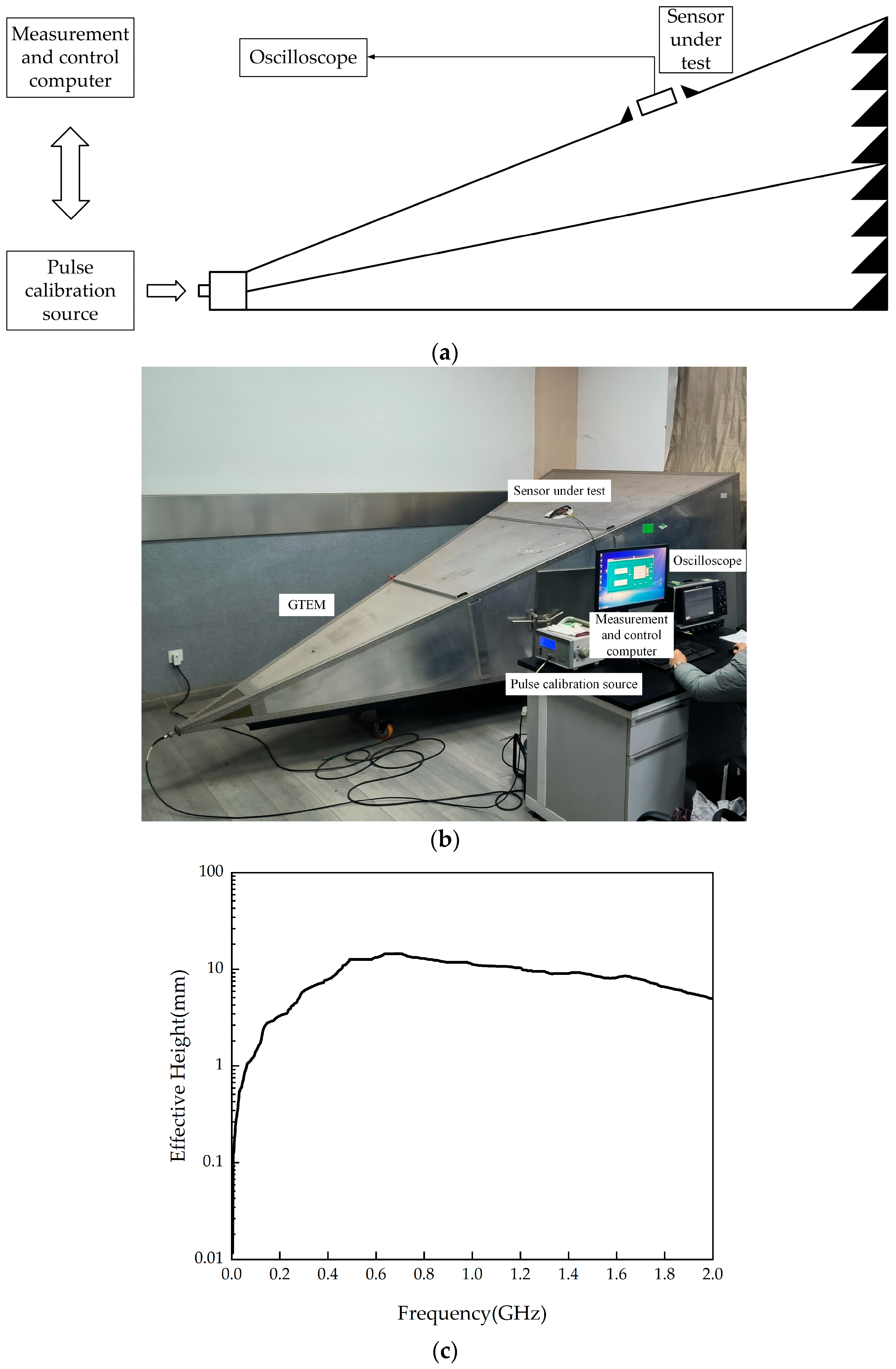
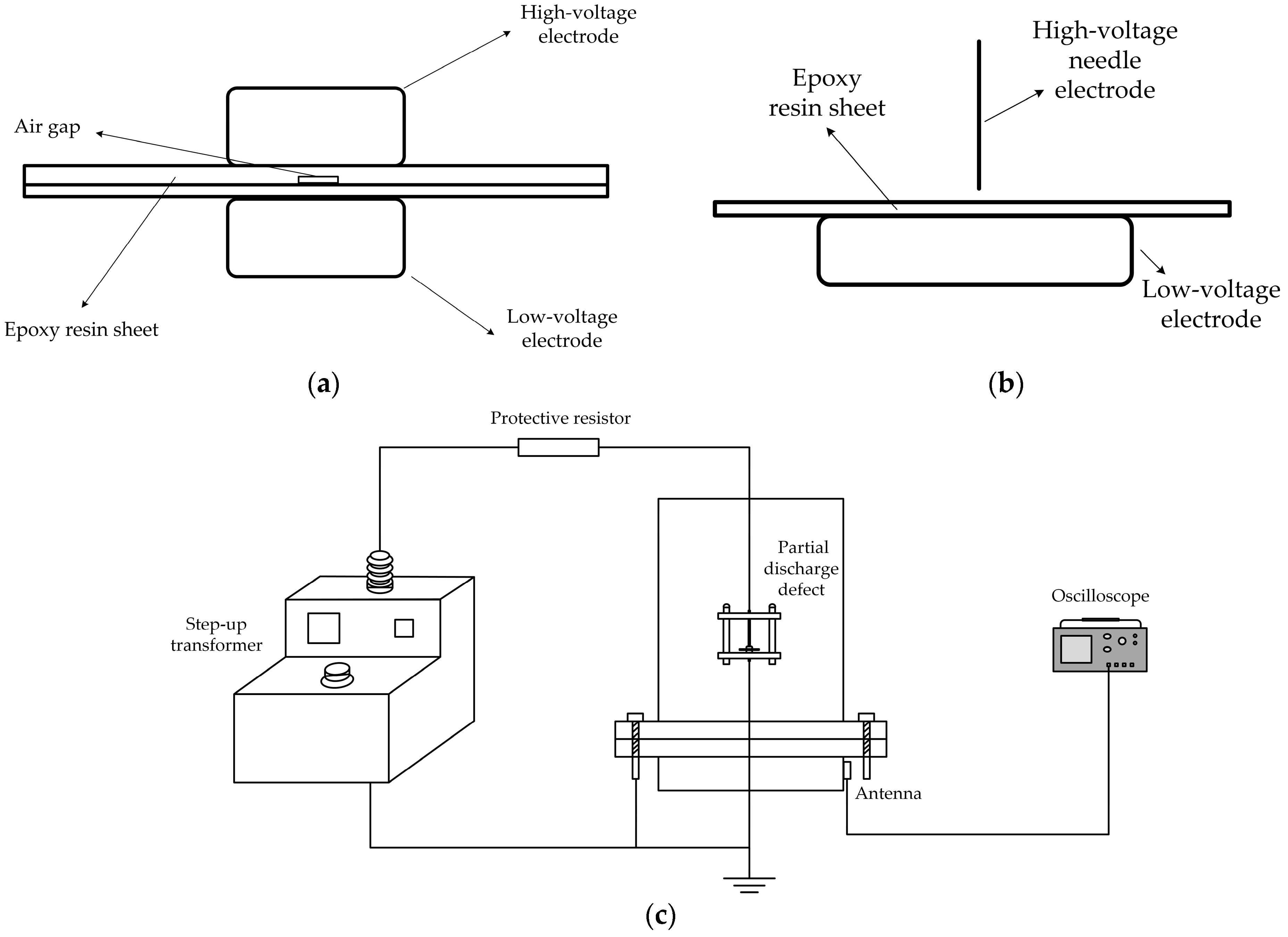

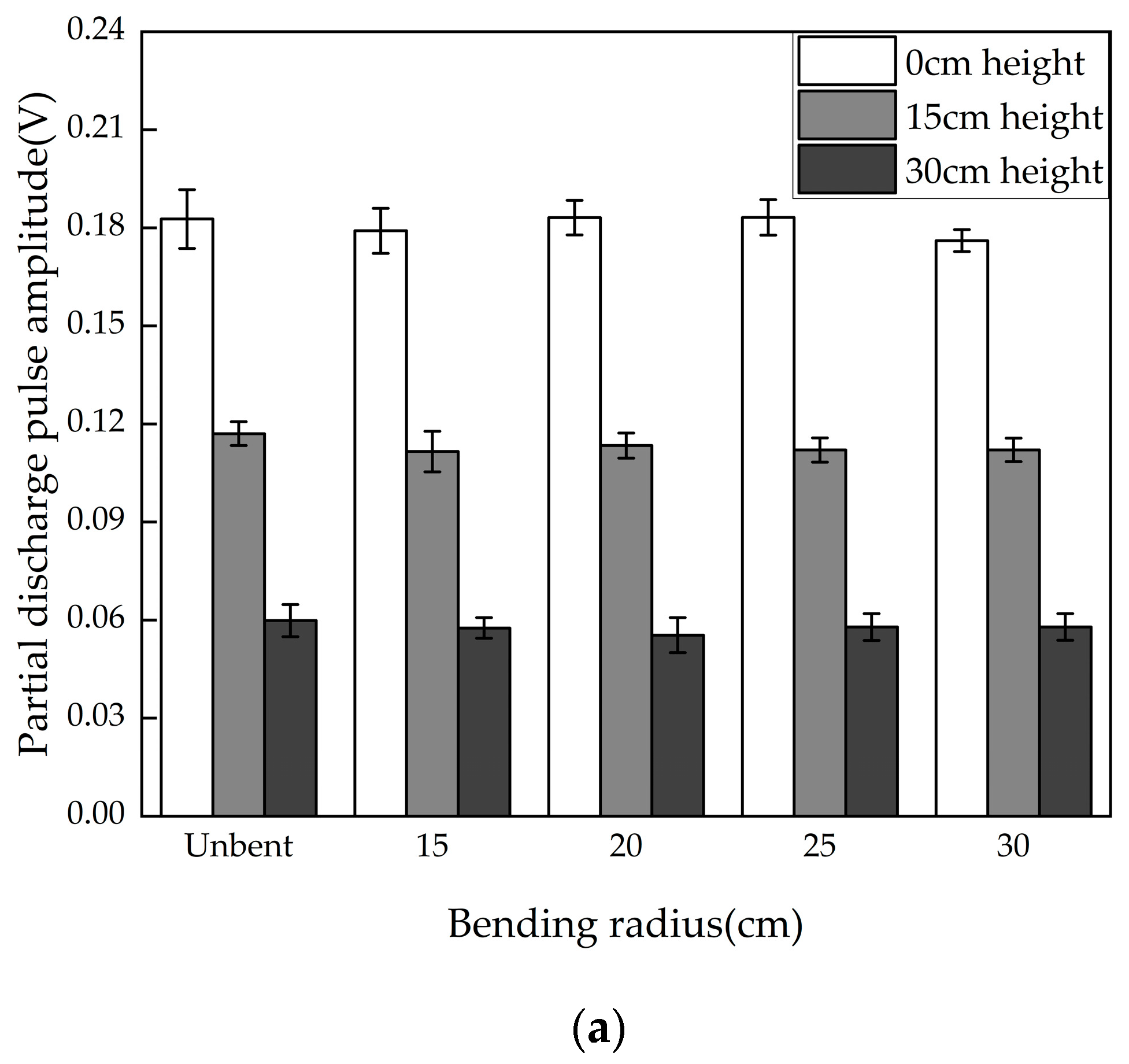
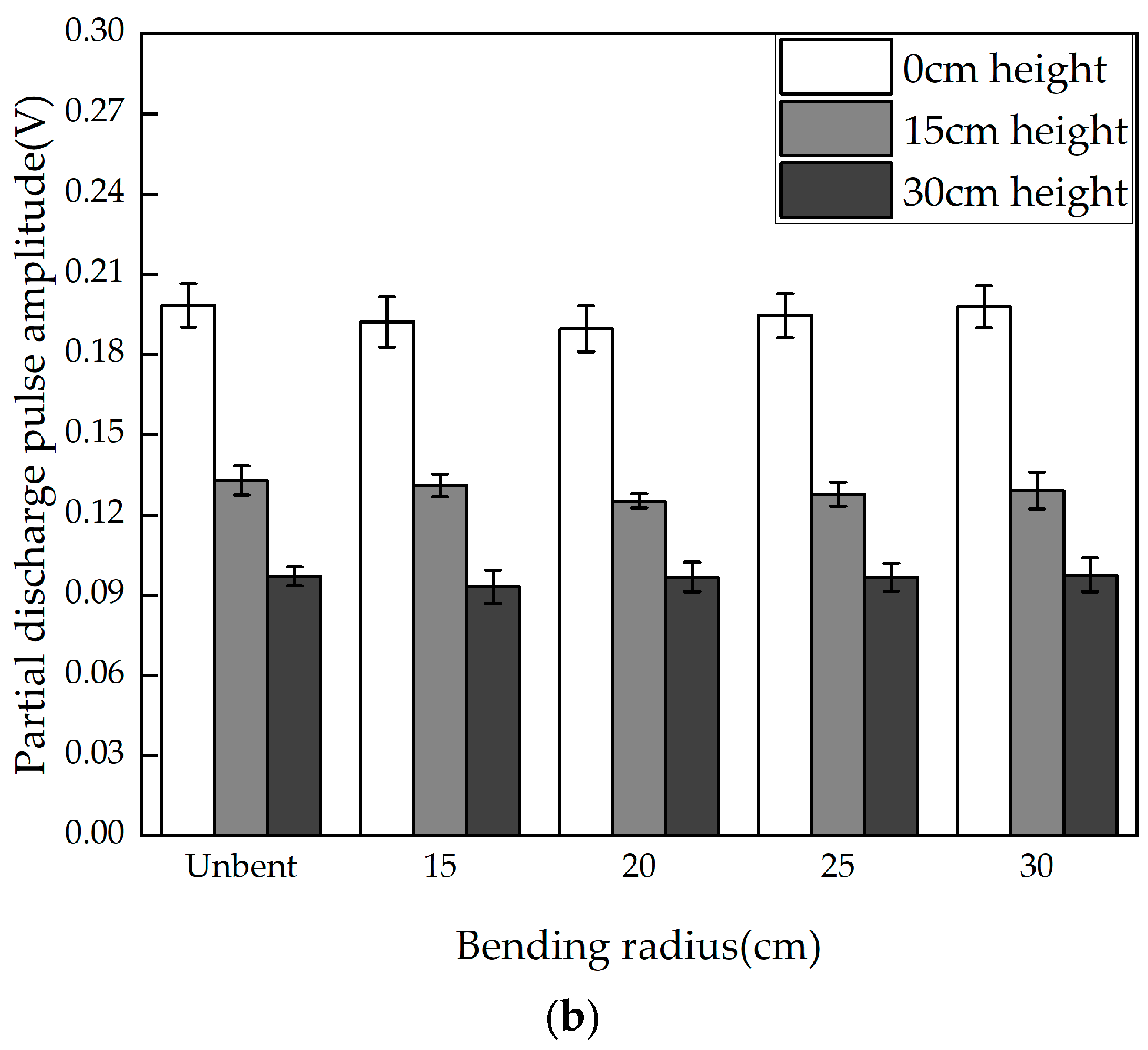
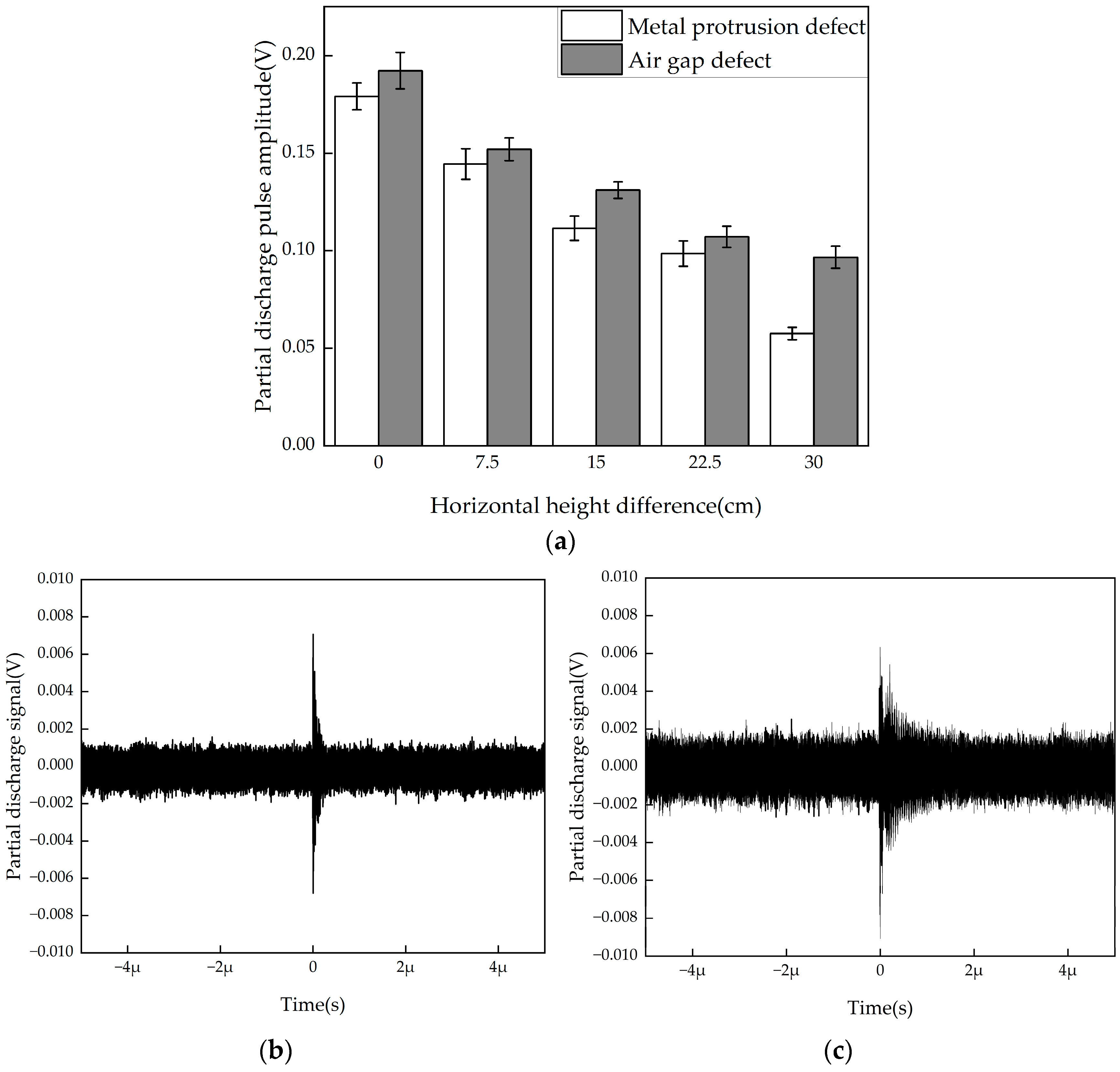

| Material | εr | tanδ |
|---|---|---|
| PI | 3.4 | 0.008 |
| PDMS | 1.68 | 0.03 |
| PET | 4 | 0.01 |
| Parameter | Size/mm |
|---|---|
| W | 70 |
| H1 | 20 |
| w | 1.4 |
| a | 53 |
| b | 69 |
| c | 32.5 |
| d | 0.178 |
| Parameter | Size/mm |
|---|---|
| W | 70 |
| H0 | 197 |
| H1 | 20 |
| w | 1.4 |
| a | 53 |
| b | 69 |
| c | 32.5 |
| d | 0.178 |
| e | 2 |
| l | 1 |
| r1 | 13 |
Disclaimer/Publisher’s Note: The statements, opinions and data contained in all publications are solely those of the individual author(s) and contributor(s) and not of MDPI and/or the editor(s). MDPI and/or the editor(s) disclaim responsibility for any injury to people or property resulting from any ideas, methods, instructions or products referred to in the content. |
© 2025 by the authors. Licensee MDPI, Basel, Switzerland. This article is an open access article distributed under the terms and conditions of the Creative Commons Attribution (CC BY) license (https://creativecommons.org/licenses/by/4.0/).
Share and Cite
Mi, Y.; Liu, W.; Peng, Y.; Deng, L.; Shu, B.; Wang, X.; Li, S. Research on Low-Profile Directional Flexible Antenna with 3D Coplanar Waveguide for Partial Discharge Detection. Micromachines 2025, 16, 253. https://doi.org/10.3390/mi16030253
Mi Y, Liu W, Peng Y, Deng L, Shu B, Wang X, Li S. Research on Low-Profile Directional Flexible Antenna with 3D Coplanar Waveguide for Partial Discharge Detection. Micromachines. 2025; 16(3):253. https://doi.org/10.3390/mi16030253
Chicago/Turabian StyleMi, Yan, Wentao Liu, Yiqin Peng, Lei Deng, Benxiang Shu, Xiaopeng Wang, and Songyuan Li. 2025. "Research on Low-Profile Directional Flexible Antenna with 3D Coplanar Waveguide for Partial Discharge Detection" Micromachines 16, no. 3: 253. https://doi.org/10.3390/mi16030253
APA StyleMi, Y., Liu, W., Peng, Y., Deng, L., Shu, B., Wang, X., & Li, S. (2025). Research on Low-Profile Directional Flexible Antenna with 3D Coplanar Waveguide for Partial Discharge Detection. Micromachines, 16(3), 253. https://doi.org/10.3390/mi16030253






